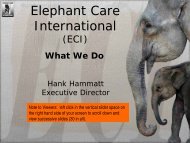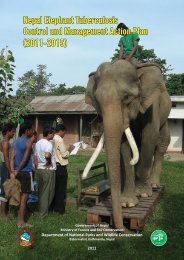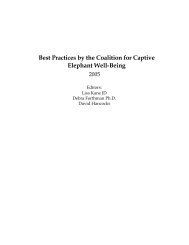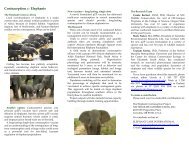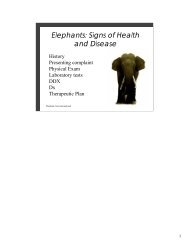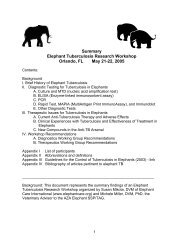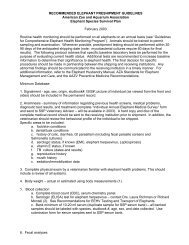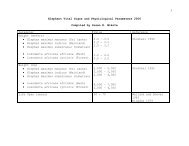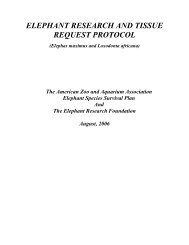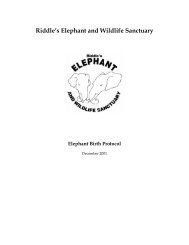AZA Standards for Elephant Management and Care - Elephant Care ...
AZA Standards for Elephant Management and Care - Elephant Care ...
AZA Standards for Elephant Management and Care - Elephant Care ...
You also want an ePaper? Increase the reach of your titles
YUMPU automatically turns print PDFs into web optimized ePapers that Google loves.
American Zoo <strong>and</strong> Aquarium Association<strong>St<strong>and</strong>ards</strong> For <strong>Elephant</strong> <strong>Management</strong> <strong>and</strong> <strong>Care</strong>Adopted 21 March 2001, Updated 5 May 2003The following st<strong>and</strong>ards apply to the husb<strong>and</strong>ry <strong>and</strong> management of both African (Loxodonta africana)<strong>and</strong> Asian (Elephas maximus) elephants in <strong>AZA</strong> accredited institutions, <strong>AZA</strong> related facilities, <strong>and</strong> nonmemberparticipants in the <strong>AZA</strong> <strong>Elephant</strong> Species Survival Plan (SSP). The intelligence, strength, <strong>and</strong>social needs of these magnificent animals can pose many challenges <strong>for</strong> captive managers. Institutionsdesiring to hold elephants should there<strong>for</strong>e underst<strong>and</strong> the substantial human, financial, <strong>and</strong> ethicalcommitments involved in appropriately maintaining these large <strong>and</strong> potentially dangerous species(Hutchins <strong>and</strong> Smith 1999). These st<strong>and</strong>ards have been developed to guide institutions that are planning<strong>and</strong> improving their elephant programs <strong>and</strong> are considered during the <strong>AZA</strong> accreditation process <strong>and</strong> nonmemberSSP participant evaluation. The <strong>AZA</strong> Board of Directors has instructed the AccreditationCommission to immediately require written verification from <strong>AZA</strong> member institutions holdingelephants, certifying that they are meeting the required st<strong>and</strong>ards (BOD 3/25/03).The <strong>AZA</strong> Board of Directors believes that the Association per<strong>for</strong>ms a valuable role in the cooperativedevelopment of st<strong>and</strong>ards <strong>for</strong> zoo <strong>and</strong> aquarium animal management <strong>and</strong> care, which are designed toadvance the collective mission of <strong>AZA</strong> <strong>and</strong> its members. The development of these st<strong>and</strong>ards <strong>and</strong> theadoption of them through the <strong>AZA</strong> accreditation process is what sets <strong>AZA</strong> members apart from roadsideanimal attractions. The Board underst<strong>and</strong>s that there will be differences of opinion as to what constitutesappropriate st<strong>and</strong>ards. <strong>St<strong>and</strong>ards</strong> evolve over time reflecting changes in knowledge, expertise, <strong>and</strong> publicperception.The <strong>AZA</strong> Board of Directors has asked the <strong>AZA</strong> <strong>Elephant</strong> SSP/TAG to begin <strong>for</strong>mulating a draft vision<strong>for</strong> the future of elephant management in <strong>AZA</strong> accredited zoos. Because current st<strong>and</strong>ards are expectedto change over time, it is recommended that members seeking to plan new elephant exhibits/careprograms look to the vision, rather than the current st<strong>and</strong>ards, <strong>for</strong> guidance on where to go in the future.Compliance with some minimum housing (specifically space, enclosure design, <strong>and</strong> elephant restraintdevice (ERD) requirements) must be implemented no later than five years from the issuance of thesest<strong>and</strong>ards (1 May 2006). Institutions must have written implementation plans <strong>for</strong> compliance with thesest<strong>and</strong>ards no later than three years from their issuance (1 May 2004). <strong>AZA</strong> accredited <strong>and</strong> relatedfacilities must meet all other provisions described here within one year (1 May 2002) of the issuance ofthese st<strong>and</strong>ards, unless the Accreditation Commission approves a variance. Failure to meet basic <strong>AZA</strong>st<strong>and</strong>ards <strong>for</strong> elephant management <strong>and</strong> care will be noted during accreditation inspections. Current nonmemberparticipants in the SSP will be given the same time schedule <strong>for</strong> compliance, but new nonmemberparticipants must meet all new st<strong>and</strong>ards prior to approval.Highlighted sections are recommendations or st<strong>and</strong>ards <strong>for</strong> which variances may be obtained.<strong>AZA</strong> <strong>St<strong>and</strong>ards</strong> For <strong>Elephant</strong> <strong>Management</strong> <strong>and</strong> <strong>Care</strong>Updated May 2003 1
Abiotic Environmental Variables1.1. Temperature1.1.1. <strong>Elephant</strong>s must be kept outside on natural substrates as much as possible. Institutionsshould consider designing exhibits that allow elephants outdoor access twenty-four hours aday -- weather, health, <strong>and</strong> safety permitting. During daylight hours, elephants keptoutdoors can tolerate moderate temperature extremes. Provisions must be made to protectanimals from adverse weather, including intense sunlight, chilling rain, sleet, etc. Animalskept outdoors must be monitored frequently at temperatures below 40 degrees F (4.4degrees C). Facilities may install outdoor heat sources to extend the amount of time theanimals are able to remain outside.1.1.2. While outdoors, all elephants must have access to shade during daylight hours intemperatures above 80 degrees F (27 degrees C) <strong>and</strong> when they are exposed to directsunlight.1.1.3. Indoor holding areas must be ventilated, <strong>and</strong> heated to a minimum temperature of at least 55degrees F (12.8 degrees C) at all times of the year. One room must be capable ofmaintaining a temperature of at least 70 degrees F (21.1 degrees C) <strong>and</strong> be free of drafts, <strong>for</strong>accommodating sick or debilitated animals.1.2. Humidity – There are no st<strong>and</strong>ards <strong>for</strong> humidity at this time. In<strong>for</strong>mation is limited, but thisdoes not seem to be of major concern <strong>for</strong> elephant management.1.3. Illumination1.3.1. Natural daylight cycles are adequate <strong>for</strong> elephants, even in temperate regions. Indoor areasmust be well illuminated during daylight hours, followed by a period of darkness.Fluorescent lighting provides a sufficient spectrum of illumination; skylights, in addition tointerior lighting, are highly recommended. Ample interior lighting must be available, as itis especially important to maintain staff safety.1.4. Space1.4.1. Indoor space must provide adequate room <strong>for</strong> animals to move about <strong>and</strong> lie down withoutrestriction. A minimum of 400 sq. ft (37.2 sq. m) is required <strong>for</strong> a single animal,approximately 800 sq. ft (74.3 sq. m) <strong>for</strong> two animals, <strong>and</strong> so on (<strong>AZA</strong> 1997). Because oftheir size <strong>and</strong> space requirements, bulls or cows with calves must have a minimum of atleast 600 sq. ft (55.7 sq. m) (<strong>AZA</strong> 1997).1.4.2. Outdoor yards must have at least 1,800 sq. ft (167.2 sq. m) <strong>for</strong> a single adult individual <strong>and</strong>an additional 900 sq. ft (83.6 sq. m) must be added <strong>for</strong> each additional animal (<strong>AZA</strong> 1997).If this space is the only location <strong>for</strong> exercise, then it is recommended that the space perelephant should be even greater.** Note: Institutions can petition <strong>for</strong> a variance from the current minimum indoor oroutdoor space st<strong>and</strong>ards. The applicant must explain why their facilities are adequate, eventhough they do not meet the minimum size st<strong>and</strong>ard. Accreditation inspectors will take aholistic approach to accreditation inspections, rather than focusing on specific sizemeasurements. Context is particularly important. For example, it may not be a problemthat the indoor space requirements are under the st<strong>and</strong>ard by a small amount if a zoo islocated in a warmer climate <strong>and</strong> the animals are outside most of the time. If, however, thezoo is located in a cooler climate <strong>and</strong> the animals are kept inside <strong>for</strong> many months duringthe winter, then the indoor space requirements must be met or, preferably, exceeded.Environmental enrichment programs should also be taken into consideration whenevaluating space available.<strong>AZA</strong> <strong>St<strong>and</strong>ards</strong> For <strong>Elephant</strong> <strong>Management</strong> <strong>and</strong> <strong>Care</strong>Updated May 2003 2
1.4.3. Mature animals can reach a vertical height of 20 ft (6.1 m). Consideration of this must begiven with regard to ceiling heights <strong>and</strong> fixtures (e.g., lights, heating units, plumbing, etc.)so that animals do not harm themselves or the facility.1.4.4. All facilities must have the ability to separate <strong>and</strong> isolate animals to address behavioralconcerns or allow veterinary procedures to occur (EMA 1999).1.4.5. Outdoor yard surfaces must consist primarily of natural substrates (e.g., soil, s<strong>and</strong>, grass)that provide good drainage <strong>and</strong> have a cleanable, dry area <strong>for</strong> feeding (EMA 1999).1.4.6. While outdoors, elephants must have access to s<strong>and</strong> or soil at all times <strong>for</strong> dust bathing(EMA 1999).1.4.7. Rocks, tree stumps, or large sturdy objects must be provided in the exhibit so that theanimals may use them <strong>for</strong> rubbing <strong>and</strong> scratching.1.4.8. <strong>Elephant</strong> containment barriers must be in good condition <strong>and</strong> able to prevent elephantescapes. A wide variety of building materials can be used as long as they are able towithst<strong>and</strong> the animals’ strength, contain the elephant in a specific space, <strong>and</strong> prohibit directcontact between elephants <strong>and</strong> the public.1.4.9. Door <strong>and</strong> gate design is extremely important to ensure the safety of both elephants <strong>and</strong>keeper staff. Both doors <strong>and</strong> gates must be engineered to withst<strong>and</strong> extreme <strong>for</strong>ce. Ifmechanical opening devices, such as hydraulic or electrically powered drives are used, theymust be able to be operated manually or with a backup generator in the case of a powerfailure.1.4.10. Enclosures must be cleaned of excrement daily. Frequent daily manure removal isrecommended <strong>and</strong> may be necessary <strong>for</strong> the maintenance of both sanitary <strong>and</strong> estheticconditions (EMA 1999).1.4.11. If the <strong>AZA</strong> <strong>Elephant</strong> SSP-managed population is to become sustainable, it is necessary tocreate housing <strong>for</strong> many more adult males (Wiese 2000, Wiese <strong>and</strong> Olson 2000). Allinstitutions considering new construction <strong>for</strong> elephants should include holding space <strong>for</strong>adult males. Institutions modifying existing facilities should also make provisions <strong>for</strong> bullhousing.1.4.12. There are no st<strong>and</strong>ards on the visual, acoustic, <strong>and</strong> olfactory needs of elephants at thistime.1.4.13. There are no specific st<strong>and</strong>ards <strong>for</strong> the transportation of elephants at this time, but seeFowler (1995).1.5. Water <strong>and</strong> Moats1.5.1. While outdoors <strong>and</strong> weather permitting, elephants must have regular access to a watersource, such as a pool, waterfall, misters/sprinklers, or wallow that provides enrichment <strong>and</strong>allows the animals to cool <strong>and</strong>/or bathe themselves.1.5.2. St<strong>and</strong>ing water in indoor floor areas can cause foot problems <strong>and</strong> become a breeding ground<strong>for</strong> bacteria. Floors must there<strong>for</strong>e be impervious to water, quick to dry, <strong>and</strong> sloped to adrain. Floor surfaces must be relatively smooth, but not enough so that they becomeslippery when wet. Conversely, very rough surfaces may cause excessive wear or irritatefootpads.1.5.3. Dry moats can pose a substantial threat to elephants <strong>and</strong> their use must be limited with theultimate goal that they are eventually phased out. Moats that are deep, narrow-sided, <strong>and</strong>hard-bottomed can be particularly dangerous. Although there should be no risk of animalsfalling or being pushed into the moat, written animal extraction protocols must be in place<strong>for</strong> any moat that is more than 3 ft (1 m) deep, less than 10 ft (3 m) wide, <strong>and</strong>/or hardbottomed.<strong>AZA</strong> <strong>St<strong>and</strong>ards</strong> For <strong>Elephant</strong> <strong>Management</strong> <strong>and</strong> <strong>Care</strong>Updated May 2003 3
2.5. Introductions – There are no specific st<strong>and</strong>ards <strong>for</strong> elephant introductions at this time, but seeLindburg <strong>and</strong> Robinson (1986) <strong>and</strong> Krantz (1996).3. Health <strong>and</strong> Nutrition3.1. Diet3.1.1. High quality <strong>and</strong> nutritionally correct food must be provided in sufficient quantities tomaintain animal health <strong>and</strong> appropriate weight (EMA 1999). Hay <strong>and</strong> grain should be<strong>for</strong>mulated to provide a complete diet as recommended by the <strong>Elephant</strong> SSP NutritionAdvisor.3.1.2. There are no specific st<strong>and</strong>ards <strong>for</strong> elephant nutrition at this time, but see Dierenfeld (1995),Oftedahl et al. (1996) <strong>and</strong> Ullrey et al (1997).3.2. Medical <strong>Management</strong>3.2.1. A veterinarian with experience in large mammal medicine must be on call at all times todeal with routine elephant health evaluation <strong>and</strong> treatment <strong>and</strong> medical emergencies.3.2.2. Each elephant must be given a thorough annual physical examination (Mikota et al. 1994).3.2.3. All elephants must be visually inspected on a daily basis (EMA 1999). A generalassessment must be made <strong>and</strong> any unusual activities should be recorded in the daily log ateach inspection. Specifically, reports should include observations such as condition ofurine <strong>and</strong> feces, eating <strong>and</strong> drinking patterns, administration of medications (if any), <strong>and</strong>general condition <strong>and</strong> behavior.3.2.4. A veterinarian or trained veterinary technician must per<strong>for</strong>m fecal examinations to look <strong>for</strong>parasites <strong>and</strong> other problems at least twice a year (Samuel et al. 2001). Results should berecorded.3.2.5. All elephants must be trained to permit a complete body daily exam (include feet, eyes,ears, open mouth <strong>and</strong> tongue, teeth, <strong>and</strong> tusks) <strong>for</strong> any sign of abnormalities. Results shouldbe recorded.3.2.6. All elephants’ body weight must be assessed <strong>and</strong> recorded at least twice a year (EMA 1999)through actual weighing or through the use of st<strong>and</strong>ardized body measurement tables,photographs, or similar, previously validated techniques (e.g., Nirmalan <strong>and</strong> Sreekumar1990).3.2.7. For management purposes, all elephants must be trained to accept injections, oralmedications, insertion of ear or leg vein catheters, treatment of wounds, enemas, <strong>and</strong>urogenital examinations (Mikota et al. 1994, EMA 1999).3.2.8. All elephants must be trained to accept regular collection of blood, urine, feces, saliva,semen, skin biopsy, <strong>and</strong> temporal gl<strong>and</strong> secretion (Brown 1998, EMA 1999). Biologicalspecimens should be stored according to the SSP Veterinary Advisor’s guidelines onbiomaterials collection.3.2.9. All elephants’ skin must be thoroughly inspected on a daily basis <strong>and</strong> cared <strong>for</strong> as neededthrough bathing, removal of dead skin, <strong>and</strong> treatment of dry skin or other skin problems(Mikota et al. 1994, EMA 1999).3.2.10. Each elephant facility must have a written protocol <strong>for</strong> routine foot care <strong>and</strong> showevidence of its implementation (Miokota et al. 1994, Csuti et al. 2001). This protocol mustinclude daily cleaning <strong>and</strong> inspection of each elephant’s feet.3.2.11. Baseline foot radiographs or thermographs of all adult elephants must be taken <strong>and</strong> kepton file. In some facilities, it may be appropriate to annually monitor selected elephants (i.e.,those that have a history of chronic foot problems) (Csuti et al. 2001).3.2.12. A written daily exercise program <strong>for</strong> each individual animal must be designed <strong>and</strong>followed (Taylor <strong>and</strong> Poole 1998). The program should be developed in consultation withthe elephant manager, elephant h<strong>and</strong>lers, <strong>and</strong> the staff veterinarian(s).<strong>AZA</strong> <strong>St<strong>and</strong>ards</strong> For <strong>Elephant</strong> <strong>Management</strong> <strong>and</strong> <strong>Care</strong>Updated May 2003 5
3.2.13. When <strong>for</strong>ming new herds, Asian <strong>and</strong> African elephants should not be placed together inthe same enclosure. Herpes viruses endemic to one species can be fatal in the other(Richman et al. 1996, 1999). In addition, there is concern that behavioral differencesbetween the two species may lead to problems with dominance <strong>and</strong> aggression (Hutchins<strong>and</strong> Smith 1999).3.2.14. Institutions must adhere to USDA APHIS requirements <strong>for</strong> testing <strong>and</strong> treatment oftuberculosis (USDA APHIS 2000, Mikota et al. 2000).4. Reproduction4.1. Each male <strong>and</strong> female elephant of reproductive age (8 to 35 years) must have an initialreproductive assessment <strong>and</strong> follow-up assessments on a regular basis by transrectal ultrasoundto verify reproductive status <strong>and</strong> assess overall reproductive health (Hermes et al. 2000,Hildebr<strong>and</strong>t et al. 2000 a,b). Exceptions include elephants with known reproductive problems,actively breeding animals, or those with documented medical/behavioral conditions that precludethem from breeding.4.2 Each male <strong>and</strong> female elephant of reproductive age (8 to 35 years) must have hormone(progesterone or testosterone) values assessed through weekly (or bi-weekly) collection of bloodsamples (Brown 1998, 2000). Exceptions are elephants with known reproductive problems orthose with documented medical/behavioral conditions that preclude them from breeding.5. Behavior management5.1. Training5.1.1. Electrical devices designed <strong>for</strong> use on livestock, such as commercially manufacturedelectric prods <strong>and</strong> shocking collars/belts, are prohibited as routine training tools or <strong>for</strong>h<strong>and</strong>ling animals during exhibition. Electric prods are permissible only as an emergencysafety device; however, their use is restricted to situations in which keepers feel theimminent need to defend themselves against elephant attacks, or to protect an elephant frompossible injury (see Schanberger et al. 2001).5.1.2. <strong>Elephant</strong> training terminology <strong>and</strong> descriptions of specific behaviors are outlined in the <strong>AZA</strong>Schools <strong>for</strong> Zoo <strong>and</strong> Aquarium Personnel Principles of <strong>Elephant</strong> <strong>Management</strong> (PEM)Course Notebook (<strong>AZA</strong> Board of Regent’s 2001). Trained behaviors should allow theelephant staff access to the animal in order to accomplish all necessary animal care <strong>and</strong>management procedures <strong>and</strong> permit inter-institutional consistency. The PEMrecommendedlist of comm<strong>and</strong>s <strong>and</strong> their corresponding behaviors are ones that everyelephant <strong>and</strong> elephant keeper must know so that basic husb<strong>and</strong>ry <strong>and</strong> veterinary practicescan be accomplished. Behaviors should be rein<strong>for</strong>ced so that all elephants attain close to100% compliance upon request of the elephant staff (Sevenich et al. 1998).Appropriate elephant training may employ several training aids or “tools” (see PEM Coursenotebook <strong>for</strong> a list <strong>and</strong> description of some elephant training tools <strong>and</strong> procedures). The goalof a good trainer is to be able to reduce the amount of time any particular training aid is used(Roocroft <strong>and</strong> Zoll 1994).The <strong>AZA</strong> considers the following training tools/techniques to be inappropriate <strong>for</strong> use atmember institutions:a. Insertion of any implement into any bodily orifice, unless directed by a veterinarianspecifically in connection with training <strong>for</strong> a medical or reproductive procedure.<strong>AZA</strong> <strong>St<strong>and</strong>ards</strong> For <strong>Elephant</strong> <strong>Management</strong> <strong>and</strong> <strong>Care</strong>Updated May 2003 6
. Striking an elephant with anything more substantial than an ankus (a traditional trainingtool used by elephant trainers)c. Striking an elephant with any sharp object, including the hook of an ankus (Fowler1995).d. Striking an elephant on or around any sensitive area, such as the eyes, mouth, ears, orgenital region.e. No tools used in training should be applied repeatedly <strong>and</strong> with such <strong>for</strong>ce that theycause any physical harm to an animal (i.e., breaking of the skin, bleeding, bruising, etc.).f. Withholding or reducing an animal’s daily-recommended amount of food <strong>and</strong> or water.g. Withholding veterinary care <strong>for</strong> any reason.If properly executed training procedures are ineffective in eliminating aggressive orinappropriate behavior in a given animal, institutions should consider other alternatives,including transfer to a facility with more experienced staff or a different managementsystem. Protracted <strong>and</strong> repeated use of corporal discipline in training is of serious ethicalconcern <strong>and</strong> <strong>AZA</strong> considers abusive training practices to be unacceptable. Further,elephants that are untrained, unexercised, or unable to complete minimum behavioralrequirements may be considered neglected <strong>and</strong> thereby abused.5.2. <strong>Management</strong> Systems – Different elephant management systems have both advantages <strong>and</strong>disadvantages (Desmond <strong>and</strong> Laulie 1991, Doyle 1993, Preist et al. 1998, Schmid 1998). <strong>AZA</strong>st<strong>and</strong>ards <strong>for</strong> elephant management recognize that a diversity of approaches exist, but encouragemembers to continue to experiment with the goal of maximizing elephant health <strong>and</strong>reproduction <strong>and</strong> minimizing risk of injury to keeper staff (Lenhardt 1991, 2001, Chapple <strong>and</strong>Ridgway 2001). System definitions have been defined in the PEM Course <strong>and</strong> are as follows:Free Contact – The direct h<strong>and</strong>ling of an elephant when the keeper <strong>and</strong> elephant share the sameunrestricted space. Neither the use of chains nor the posture of the elephant alters this definition.Protected Contact – H<strong>and</strong>ling of an elephant when the keeper <strong>and</strong> the elephant do not share thesame unrestricted space. Typically in this system the keeper has contact with the elephantthrough a protective barrier of some type while the elephant is not spatially confined <strong>and</strong> is freeto leave the work area at will. This includes confined contact, where the h<strong>and</strong>ling of an elephantthrough a protective barrier where the elephant is spatially confined, as in an <strong>Elephant</strong> RestraintDevice (ERD).5.3. <strong>Management</strong> Protocols – Each <strong>AZA</strong> member institution <strong>and</strong> related facility that holds elephantsmust have a written elephant management policy. This policy must be consistent with <strong>AZA</strong>st<strong>and</strong>ards <strong>for</strong> elephant management <strong>and</strong> care, <strong>and</strong> must, at minimum, include a description of theinstitution’s:a. <strong>Elephant</strong> management program’s missions <strong>and</strong> goals (EMA 1999).b. <strong>Elephant</strong> management policies, including guidelines <strong>for</strong> h<strong>and</strong>ling, training, <strong>and</strong> translocation(EMA 1999).c. Plan to separate animals from each other, safely manage elephants that are aggressive towardother elephants, safely move elephants from one location to another, <strong>and</strong> safely manageelephants that are aggressive toward humans (EMA 1999).d. Staff management policies, including guidelines <strong>for</strong> keeper safety (EMA 1999).e. Individual elephant profiles <strong>and</strong> incident reports <strong>for</strong> all cases in which elephants showaggression toward keepers or the public, regardless if any injury actually resulted.<strong>AZA</strong> <strong>St<strong>and</strong>ards</strong> For <strong>Elephant</strong> <strong>Management</strong> <strong>and</strong> <strong>Care</strong>Updated May 2003 7
f. Emergency response protocol. Institutions should be able to demonstrate readiness torespond to an emergency situation, such as an elephant escape or keeper injury (EMA 1999).5.4. Safety5.4.1. All elephant-holding institutions must undertake at least a semi-annual elephant facility <strong>and</strong>program safety assessment, identify safety needs, <strong>and</strong> fully implement any correctivemeasures. Each facility shall establish a safety assessment team. The team may includeelephant staff, management staff, animal health care staff, <strong>and</strong> experts in the area of riskmanagement <strong>and</strong> safety. Each facility should establish the make-up of the team based on itsown needs <strong>and</strong> resources. A written record must be kept <strong>for</strong> each inspection <strong>and</strong> that recordbe reviewed <strong>and</strong> its recommendations acted upon.5.4.2. In the interest of public safety, <strong>AZA</strong> strongly discourages visitor-elephant interactions,outside of the primary enclosure. <strong>AZA</strong> strongly discourages the practice of walkingelephants in public areas during public hours (BOD 3/25/03).5.4.3. In the interest of safety, <strong>AZA</strong> strongly encourages members to discontinue public elephantrides (BOD 3/21/00).5.5. Restraint5.5.1. Chaining is acceptable as a method of temporary restraint (Fowler 1995). However,elephants must not be subjected to prolonged chaining (<strong>for</strong> the majority of a 24-hour period)unless necessary <strong>for</strong> veterinary treatment or transport. Institutions that regularly use chains<strong>for</strong> some portion of a day must alternate the chained foot on a daily basis. All newconstruction <strong>and</strong> major renovations must be constructed in a manner that minimizes oreliminates the need <strong>for</strong> chaining (Schmid 1995, Gruber et al. 2000).**Note: If <strong>AZA</strong> policies on chaining require new construction, rather than proceduralchanges, then institutions will have five years to comply with this requirement. Plans mustbe in place within three years <strong>and</strong> institutions must apply <strong>for</strong> a variance from the <strong>AZA</strong>Accreditation Commission.5.5.2. All elephant holding facilities should install an <strong>Elephant</strong> Restraint Device (ERD) (Schmidtet al. 1991). However, all bull-holding facilities, as well as those that manage elephants inprotected contact, must have an ERD. Use of the ERD should not be weather dependent.5.5.3. Each elephant must be trained to enter <strong>and</strong> stay in the ERD, if one is available, <strong>for</strong>husb<strong>and</strong>ry, veterinary, reproductive assessment, <strong>and</strong> other procedures to occur in a safe <strong>and</strong>efficient manner (Schmidt 1991).5.5.4. If a facility does not have an ERD, staff must demonstrate a method of restraint that allowsnecessary husb<strong>and</strong>ry, veterinary, <strong>and</strong> reproductive procedures to occur in a safe <strong>and</strong>efficient manner (Fowler 1995).6. Staff Organization <strong>and</strong> Training6.1. Each institution must have one person, designated as the elephant manager. This individual isresponsible <strong>for</strong> (1) staff training; (2) developing <strong>and</strong> maintaining the program; <strong>and</strong> (3)communicating with others about the elephant program. The elephant manager must alsodemonstrate knowledge about all emergency protocols <strong>and</strong> continually improve elephantmanagement techniques as the industry st<strong>and</strong>ards evolve.6.2. All elephant managers must attend the <strong>AZA</strong> Principles of <strong>Elephant</strong> <strong>Management</strong> Course (BOD3/25/03), preferably within 18 months following acceptance/promotion to the position. Inaddition, every elephant keeper is encouraged to attend this course. The BOD directs the Boardof Regents to develop a mechanism <strong>for</strong> the PEM graduates to remain current in best practices inelephant management (BOD 3/25/03).<strong>AZA</strong> <strong>St<strong>and</strong>ards</strong> For <strong>Elephant</strong> <strong>Management</strong> <strong>and</strong> <strong>Care</strong>Updated May 2003 8
<strong>AZA</strong> Regents. 2001. <strong>AZA</strong> Schools <strong>for</strong> Zoo <strong>and</strong> Aquarium Personnel: Principles of <strong>Elephant</strong><strong>Management</strong>. American Zoo <strong>and</strong> Aquarium Association, Silver Spring, MD.Brown, J. (1998) The need <strong>for</strong> routine elephant blood draws. Animal Keeper’s Forum 25: 357-359.Brown, J. 2000. Reproductive endocrine monitoring of elephants: An essential tool <strong>for</strong> assisting captivemanagement. Zoo Biology 19: 347-367.Chapple, C. <strong>and</strong> Ridgway, D. 2001. <strong>Elephant</strong> h<strong>and</strong>ling <strong>and</strong> an analysis of the risks. Journal of the<strong>Elephant</strong> Manager’s Association 11: 163-165.Csuti, B., Sargent, E.L., <strong>and</strong> Bechert, U.S., eds. 2001. The <strong>Elephant</strong>’s Foot: Prevention <strong>and</strong> <strong>Care</strong> of FootConditions in Captive Asian <strong>and</strong> African <strong>Elephant</strong>s. Iowa State University Press, Ames, IA.Desmond, T. & G. Laule. 1991. Protected contact: <strong>Elephant</strong> h<strong>and</strong>ling. Pp. 84-91 in Proceedings of the12 th International <strong>Elephant</strong> Workshop. Burnet Park Zoo, Syracuse, NY.Dierenfeld, E. 1995. Nutrition <strong>and</strong> feeding. Journal of the <strong>Elephant</strong> Manager’s Association 6: 32-39.Doyle, C. 1993. Protected/confined contact as a supplement in a free contact system. Pp. 30-32 inProceedings of the 14 th Annual <strong>Elephant</strong> Managers Conference. Marine World Africa USA, Vallejo, CA.EMA 1999. The EMA st<strong>and</strong>ard guidelines <strong>for</strong> elephant management. Journal of the <strong>Elephant</strong> Manager’sAssociation 10: 203-204.Fowler, M.E. 1995. Restraint <strong>and</strong> H<strong>and</strong>ling of Wild <strong>and</strong> Domestic Animals. Second Edition. Iowa StateUniversity Press, Ames, IA.Gruber, T.M., Friend, T.H., Packard, J.M., Beaver, B., <strong>and</strong> Bushong, D. 2000. Variation in stereotypicbehavior related to restraint in circus elephants. Zoo Biology 19: 209-221.Hermes, R., Olson, D., Goritz, F., Brown, J.L., Schmitt, D.L., Hagan, D., Peterson, J.S., Fritsch, G., <strong>and</strong>Hildebr<strong>and</strong>t, T.B. 2000. Ultrasonography of the estrous cycle in female African elephants (Loxotanaafricana). Zoo Biology 19: 369-382.Hildebr<strong>and</strong>t, T.B., Goritz, F., Pratt, N., Brown, J.L., Montali, R., Schmidt, D.L., Fritsch, G. <strong>and</strong> Hermes,R. 2000a. Ultrasonography of the urogential tract in elephants (Loxotana africana <strong>and</strong> Elaphas maximus):An important tool <strong>for</strong> assessing female reproductive function. Zoo Biology 19: 321-332.Hildebr<strong>and</strong>t, T.B., Hermes, R., Pratt, N.C., Fritsch, G., Blottner, S., Schmidt, D.L., Ratanakorn, P.,Brown, J.L., Reitschel, W. <strong>and</strong> Goritz, F. 2000b. Ultrasonography of the urogential tract in elephants(Loxotana africana <strong>and</strong> Elaphas maximus): An important tool <strong>for</strong> assessing male reproductive function.Zoo Biology 19: 333-345.Hutchins, M. <strong>and</strong> B.R. Smith. 1999. <strong>AZA</strong> <strong>Elephant</strong> Planning Initiative: On the Future of <strong>Elephant</strong>s inNorth American Zoos. American Zoo <strong>and</strong> Aquarium Association, Silver Spring, MD.Keele, M. <strong>and</strong> N. Dimeo-Ediger. 1997. <strong>AZA</strong> <strong>Elephant</strong> Masterplan 1997-2002. Oregon Zoo, Portl<strong>and</strong>,OR.<strong>AZA</strong> <strong>St<strong>and</strong>ards</strong> For <strong>Elephant</strong> <strong>Management</strong> <strong>and</strong> <strong>Care</strong>Updated May 2003 10
Krantz, K. 1996. Introduction, socialization <strong>and</strong> crate training. Pp. 78-87 in Kleiman, D.G., Allen, M.,Thompson, K.V., <strong>and</strong> Lumpkin, S., eds. Wild Mammals in Captivity. Smithsonian Institution Press,Washington, DC.Lenhardt, J. 1991. <strong>Elephant</strong> h<strong>and</strong>ling: A problem of risk management <strong>and</strong> resource allocation. AAZPAAnnual Conference Proceedings: 569-575.Lenhardt, J. 2001. Response. Journal of the <strong>Elephant</strong> Manager’s Association 11: 165-166.Lindburg, D.G. <strong>and</strong> Robinson, P. 1986. Animal introductions: Some suggestions <strong>for</strong> easing the trauma.Animal Keeper’s Forum 13: 8-11.Mikota, S.K., Larson, R.S. <strong>and</strong> Montali, R. 2000. Tuberculosis in elephants in North America. ZooBiology: 393-403.Mikota, S.K., Sargent, E., <strong>and</strong> Ramglack, G.S. 1994. Medical <strong>Management</strong> of the <strong>Elephant</strong>. IndriaPublishing House, West Bloomfield, MI.Oftedahl, O., Baer, D.J., <strong>and</strong> Allen, M.E. 1996. The feeding <strong>and</strong> nutrition of herbivores. Pp. 129-138 inKleiman, D.G., Allen, M., Thompson, K.V., <strong>and</strong> Lumpkin, S., eds. Wild Mammals in Captivity.Smithsonian Institution Press, Washington, DC.Samuel, W.M., Pybus, M.J., <strong>and</strong> Kocan, A.A. 2001. Parasitic Diseases of Wild Mammals. SecondEdition. Iowa State University Press, Ames, IA.Sreekumar, K.P. <strong>and</strong> Nirmalan, G. 1990. Estimation of body weight in Indian elephants (Elaphusmaximus indicus). Veterinary Research Communication 14: 5-17.Priest, G., Antrim, J. Gilbert, J. <strong>and</strong> Hare, V. 1998. Managing multiple elephants using protected contactat San Diego’s Wild Animal Park. Soundings 23 (1): 20-24.Rassmussen, L.E.L., Schmidt, M.J., Henneous, R., Groves, D., Daves, G.D. Jr. 1982. Asian bullelephants: Flehman-like responses to extractable components in female elephant estrus urine. Science217: 159-162.Richman, L.K., R.J. Montali, R.C. Cambre, J.M. Lehnhardt, Kennedy, S.K. Potgieter, L. 1996.Endothelial inclusion body disease: A newly recognized fatal herpes-like infection in Asian elephants.Proceedings of the American Association of Zoo Veterinarians’ Annual Conference: 483-485.Richman, L.K., R.J. Montali, R.L. Gerber, M.A. Kennedy, J. Lenhardt, T. Hildebr<strong>and</strong>t, D. Schmitt, D.Hardy, D.J. Alecendor & G.S. Hayward. 1999. Novel endotheliotropic herpesviruses fatal <strong>for</strong> Asian <strong>and</strong>African elephants. Science 283: 1-5.Roocroft, A. <strong>and</strong> Zoll, A.T. 1994. Managing <strong>Elephant</strong>s: An Introduction to Their Training <strong>and</strong><strong>Management</strong>. Fever Tree Press, Ramona, CA.Schanberger, A. et al. 2001. Discussion on chaining, electricity continues. Journal of the <strong>Elephant</strong><strong>Management</strong> Association 11: 160-161.Schmid, J. 1995. Keeping circus elephants temporarily in paddocks-The effects on their behaviour.Animal Welfare 4: 87-101.<strong>AZA</strong> <strong>St<strong>and</strong>ards</strong> For <strong>Elephant</strong> <strong>Management</strong> <strong>and</strong> <strong>Care</strong>Updated May 2003 11
Schmid, J. 1998. H<strong>and</strong>s off, h<strong>and</strong>s on: Some aspects of keeping elephants. International Zoo News 45:476-486.Schmidt, M.J., Henneous, R.L., Haight, J.D., Rutkowski, C., <strong>and</strong> San<strong>for</strong>d, J. 1991. The <strong>Elephant</strong> RestraintChute Owner’s Manual. Washington Park Zoo, Portl<strong>and</strong>, OR.Sevenich, M., Upchurch, B., <strong>and</strong> Mellen, J. 1998. The science of animal management: Evaluating theeffects of training <strong>and</strong> enrichment on elephant behavior. Journal of the <strong>Elephant</strong> Manager’s Association9: 201-205.Shepherdson, D.J. 1999. Environmental enrichment <strong>for</strong> elephants: Current status <strong>and</strong> future directions.Journal of the <strong>Elephant</strong> Manager’s Association 10: 69-77.Shepherdson, D.J., Mellen, J.D., <strong>and</strong> Hutchins, M. eds. 1998. Second Nature: EnvironmentalEnrichment <strong>for</strong> Captive Animals. Smithsonian Institution Press, Washington, D. C.Smith, B. <strong>and</strong> Hutchins, M. 2000. The value of captive breeding programmes to field conservation:<strong>Elephant</strong>s as an example. Pachyderm 28: 101-109.Sukumar, R. 1992. The Asian <strong>Elephant</strong>: Ecology <strong>and</strong> <strong>Management</strong>. Cambridge University Press,Cambridge, U.K.Taylor, V.J. <strong>and</strong> Poole, T.B. 1998. Captive breeding <strong>and</strong> infant mortality in Asian elephants: Acomparison between twenty western zoos <strong>and</strong> three eastern elephant centers. Zoo Biology 17: 311-332.Ullrey, D.E., Crissey, S.D., <strong>and</strong> Hintz, H.F. 1997. <strong>Elephant</strong>s: Nutrition <strong>and</strong> dietary husb<strong>and</strong>ry. Fact sheet#004. <strong>AZA</strong> Nutrition Advisory Group H<strong>and</strong>book. American Zoo <strong>and</strong> Aquarium Association, Bethesda,MD.USDA APHIS. 2000. Guidelines <strong>for</strong> the Control of Tuberculosis in <strong>Elephant</strong>s. United States Departmentof Agriculture, Washington, DC.Wiese, R.J. 2000. Asian elephants are not self-sustaining in North America. Zoo Biology 19: 299-309.Wiese, R.J. <strong>and</strong> Hutchins, M. 1994. Species Survival Plans: Strategies <strong>for</strong> Wildlife Conservation.American Zoo <strong>and</strong> Aquarium Association, Bethesda, MD.Wiese, R.J. <strong>and</strong> Olson, D. 2000. State of the North American African elephant population <strong>and</strong> projections<strong>for</strong> the future. Zoo Biology 19: 311-320.<strong>AZA</strong> <strong>St<strong>and</strong>ards</strong> For <strong>Elephant</strong> <strong>Management</strong> <strong>and</strong> <strong>Care</strong>Updated May 2003 12



